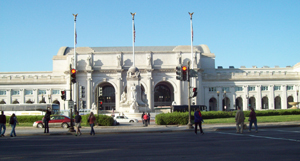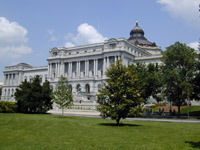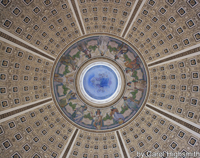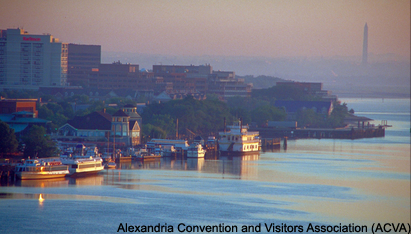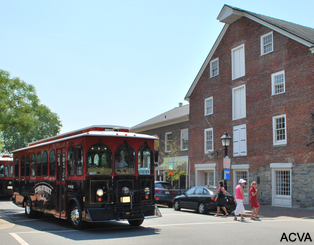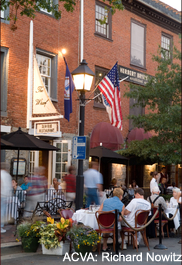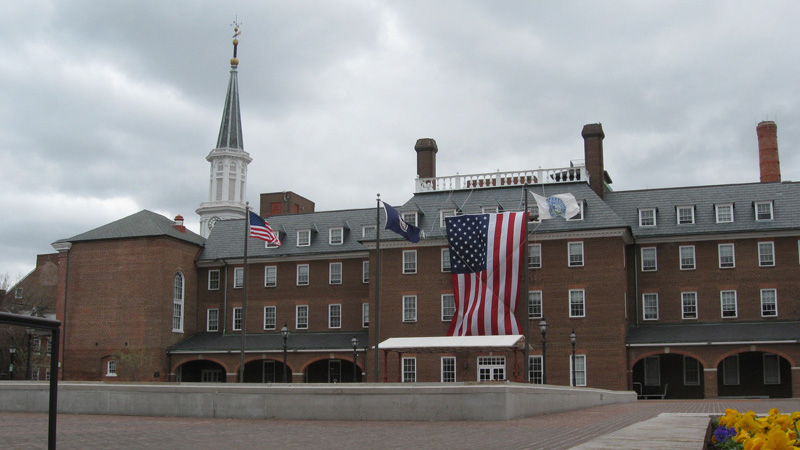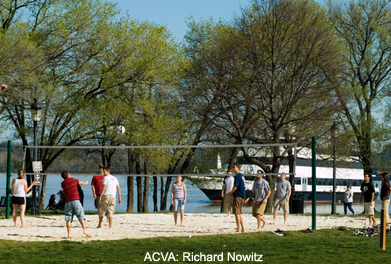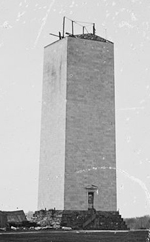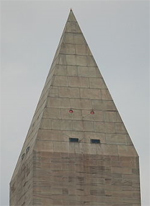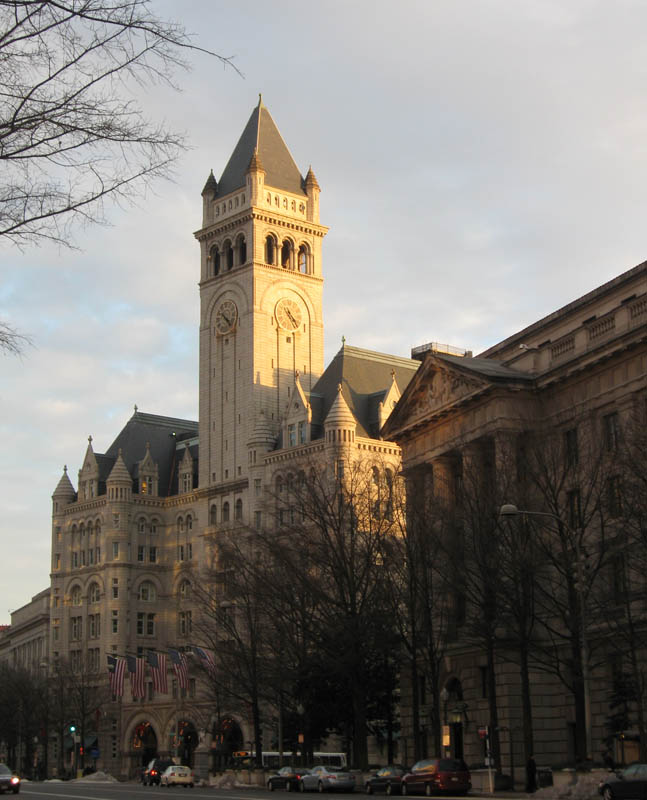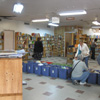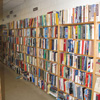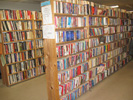Archive for the ‘adventure’ Category
Adventures at Union Station
This post is part 6 of our Wednesday Adventure Series. Each week we will highlight something different in the Washington, D.C., Metro Area, many of which will be options for part of your own BookCrossing Journey. With so many things to see and do, how will you choose?
Special Deals! – We will now be offering special deals — anything from getting entered into a drawing for a special item to earning extra raffle tickets. Check now for the current deals and take advantage of them quickly because they will only be available for a short time.
Union Station is one of the busiest places in Washington, D.C. You can find people coming and going from the Metro, Amtrak, MARC, and VRE as well as people sightseeing, shopping, working, and viewing a bit of history that dates back to its opening in 1907.
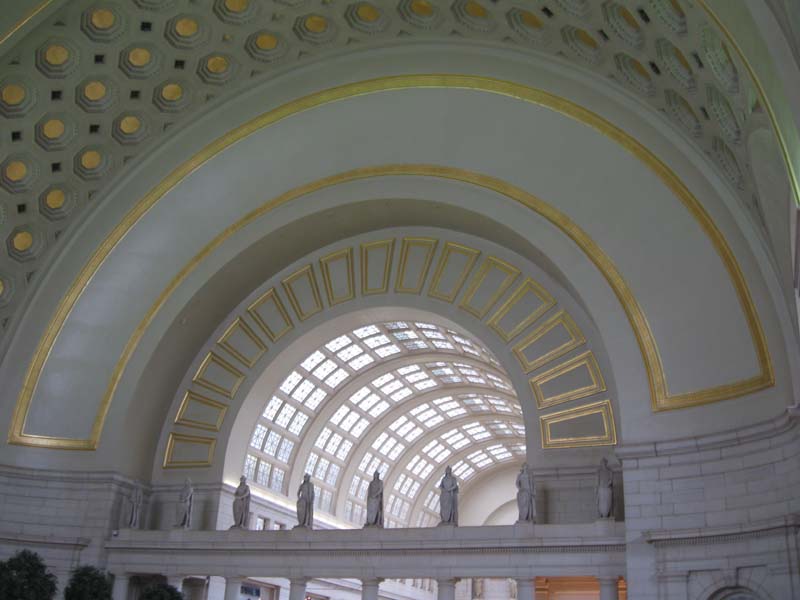 The red line Metro station area of Union Station looks like any other platform in the Metro system, with the same architecture and features. But you only need to leave the station area to be awestruck by the grandeur of Union Station itself. The Main Hall has an impressive design with great arched ceilings, beautiful artwork, and sculptures. Don’t forget to go outside and look at the front, with its grand facade that sits in an intersection designed by Pierre L’Enfant, who also designed the city plan of Washington. If you are interested in historic buildings you will be delighted to know that Union Station is on the National Register of Historic Places. Statues and plaques inside and out – including a large sculpture of Christopher Columbus out front – may captivate others, especially the Markeroni.com members among us. (A list of nearby historical markers will be provided upon request.)
The red line Metro station area of Union Station looks like any other platform in the Metro system, with the same architecture and features. But you only need to leave the station area to be awestruck by the grandeur of Union Station itself. The Main Hall has an impressive design with great arched ceilings, beautiful artwork, and sculptures. Don’t forget to go outside and look at the front, with its grand facade that sits in an intersection designed by Pierre L’Enfant, who also designed the city plan of Washington. If you are interested in historic buildings you will be delighted to know that Union Station is on the National Register of Historic Places. Statues and plaques inside and out – including a large sculpture of Christopher Columbus out front – may captivate others, especially the Markeroni.com members among us. (A list of nearby historical markers will be provided upon request.)
If you are looking for something to do near Union Station, we have a couple of suggestions for you. You can take advantage of the shopping within Union Station (there is a Barnes & Noble and a Fantom Comics for the book-lovers among us) and several places to purchase souvenirs, postcards, and other touristy items. If you have a bit of extra time you only have to cross 1st Street to the Smithsonian’s National Postal Museum(free admission) where one highlight is sending a postcard from their own metering machine. (Bring small change with you for the stamp.)
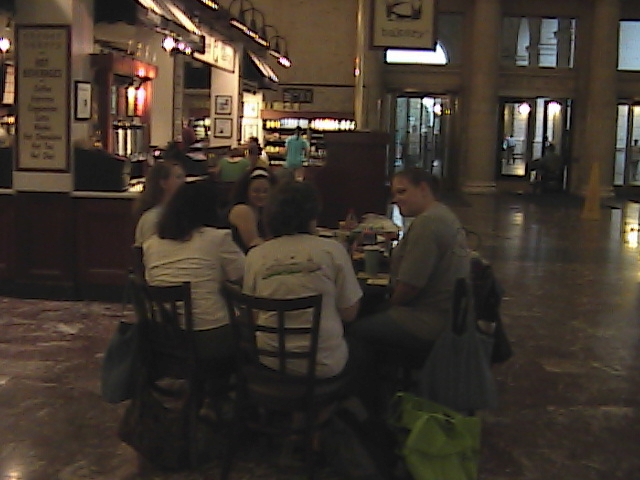 Union Station is not only a wonderful place to visit, but its central location has made it the site of a few BCinDC meetings. The food court and numerous other small restaurants are great places to sit and chat for a while enjoying the company of BookCrossers. The only downside is a few security officers who do not understand BookCrossing have asked us not to advertise the free books in any way. It is also to be noted that the cleaning staff is diligent and wild released books may end up in the trash.
Union Station is not only a wonderful place to visit, but its central location has made it the site of a few BCinDC meetings. The food court and numerous other small restaurants are great places to sit and chat for a while enjoying the company of BookCrossers. The only downside is a few security officers who do not understand BookCrossing have asked us not to advertise the free books in any way. It is also to be noted that the cleaning staff is diligent and wild released books may end up in the trash.
Union Station will be the starting point for our Extreme Early Bird activity on Thursday, which you can register for now. After getting something to eat on your own in the food court at 5:00 PM, we will meet in the Main Hall at 6:45 PM to board our tour bus just outside the front doors. From there, we will take a moonlit tour of the Washington, D.C., monuments.
Adventures at the Library of Congress
This post is part 5 of our Wednesday Adventure Series. Each week we will highlight something different in the Washington, D.C., Metro Area, many of which will be options for part of your own BookCrossing Journey. With so many things to see and do, how will you choose?
Reminder: There’s a little over a month left to register for the convention before prices rise. Hotel rooms are selling out quickly; some nights are already sold out. Reserve now to avoid disappointment!
We like to think of BookCrossing as the World’s Library. During the 2011 BookCrossing Convention, the World’s Library will meet the world’s largest library when BookCrossers have a chance to tour the Library of Congress in Washington, D.C.
With an ever-growing collection of more than 144 million items, including more than 33 million books and other printed materials in 460 languages, the Library of Congress is, indeed, the largest library in the world. An agency of the federal government, the Library is the research arm of the U.S. legislature and a resource for schools, libraries, publishers, and researchers throughout the world. Some of the collection is available online at http://www.loc.gov.
Congress established the Library in 1800 with a budget of $5,000 for buying books. It was housed in the Capitol until 1814, when the invading British army burned the building and pillaged the collection. Soon afterward, retired U.S. President Thomas Jefferson stepped in to offer his personal library – one of the best collections in America – as a replacement. Jefferson, who once wrote, “I cannot live without books,†had developed a unique cataloging system for his own books, different from the Dewey Decimal System that is more familiar to many readers. Today’s Library uses both systems when it creates cataloging records that are used by libraries around the world.
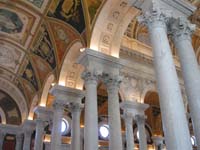 The copyright law of 1870 expanded the collection by requiring copyright applicants to send the Library two copies of each work. The resulting flood of books, pamphlets, music, prints, and photographs overflowed its space in the Capitol. So in 1897, the Library moved to its own building, the gorgeously decorated Thomas Jefferson Building, built in the Italian Renaissance style.
The copyright law of 1870 expanded the collection by requiring copyright applicants to send the Library two copies of each work. The resulting flood of books, pamphlets, music, prints, and photographs overflowed its space in the Capitol. So in 1897, the Library moved to its own building, the gorgeously decorated Thomas Jefferson Building, built in the Italian Renaissance style.
Most tours today focus on the Jefferson Building, but the Library now has two other locations on Capitol Hill – the John Adams Building and the James Madison Memorial Building – as well as off-site facilities.
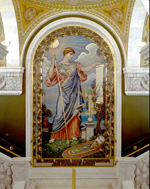 Visitors to the Library can gape at the elaborate art and architecture of the Jefferson Building. Interestingly, almost all historical figures depicted in the artwork are men, while almost all of the mythical and allegorical figures are women. The building’s original gas lighting fixtures, a novelty in their time, are still in use but have been converted to electricity. A Gutenberg Bible and other priceless books are on display under glass in climate-controlled cases, their pages turned regularly to keep any single spread from fading unduly.
Visitors to the Library can gape at the elaborate art and architecture of the Jefferson Building. Interestingly, almost all historical figures depicted in the artwork are men, while almost all of the mythical and allegorical figures are women. The building’s original gas lighting fixtures, a novelty in their time, are still in use but have been converted to electricity. A Gutenberg Bible and other priceless books are on display under glass in climate-controlled cases, their pages turned regularly to keep any single spread from fading unduly.
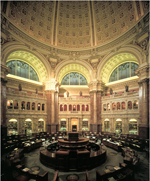 Visitors are not allowed to check books out of the library. But serious scholars can arrange to do research in the magnificent Main Reading Room and other reading rooms at the library, where staff will bring them books and other materials. Visitors can survey the grandeur of the Main Reading Room from a balcony overlook.
Visitors are not allowed to check books out of the library. But serious scholars can arrange to do research in the magnificent Main Reading Room and other reading rooms at the library, where staff will bring them books and other materials. Visitors can survey the grandeur of the Main Reading Room from a balcony overlook.
When you tour the Library of Congress, don’t forget to look up. The decorated ceilings inside the Jefferson Building are beautiful. And beneath the main floors, in underground tunnels that connect the buildings of the Capitol complex, conveyor belts run overhead. The conveyor belts carry books to their destinations. But books aren’t the only ones that can hitch a ride. A small “train†runs through some of the tunnels, carrying employees and visitors to and from the Capitol. And a new tunnel connects the Library to the new Capitol Visitor Center.
In addition to providing services to researchers, legislators, and libraries, the Library of Congress hosts special events. Many author talks, concerts, lectures, and traveling exhibits are open to the public. The annual National Book Festival attracts thousands of visitors who come to buy books, meet their favorite authors, learn about literary resources throughout the country, participate in book-related activities, and yes, share their love of reading by wild-releasing books all over the National Mall.
A guided tour of this amazing library is one activity you can choose during the 2011 Convention, either early on Friday morning or on Saturday. Tour size is limited to only 60 participants, so be sure to visit the Add-Ons and sign up for it today. If you prefer, you can take a self-guided tour at any time, using the tour pamphlets and interactive video terminals throughout the library.
Adventures in Old Town Alexandria
This post is part 4 of our Wednesday Adventure Series. Each week we will highlight something different in the Washington, D.C., Metro Area, many of which will be options for part of your own BookCrossing Journey. With so many things to see and do, how will you choose?
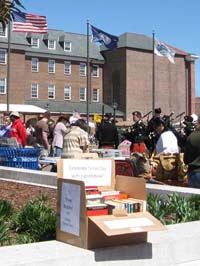 The town of Alexandria was founded by Scottish merchants in 1749 and was a major port on the Potomac River during colonial times, located directly across the river from Washington, D.C. Today it is one of America’s most historic destinations, rich with 18th and 19th century architecture, shops, attractions, and history. Old Town Alexandria is centered on King Street, roughly bounded on one side by the river and the other side by the George Washington National Masonic Memorial.
The town of Alexandria was founded by Scottish merchants in 1749 and was a major port on the Potomac River during colonial times, located directly across the river from Washington, D.C. Today it is one of America’s most historic destinations, rich with 18th and 19th century architecture, shops, attractions, and history. Old Town Alexandria is centered on King Street, roughly bounded on one side by the river and the other side by the George Washington National Masonic Memorial.
 Old Town Alexandria was the third historic district to be placed on the National Register of Historic Places. Some of its attractions include Gadsby’s Tavern (frequented by Thomas Jefferson), Robert E. Lee’s boyhood home, a replica of the townhouse George Washington had in Alexandria, the Lyceum history museum, and the Athenaeum art gallery. Alexandria’s significance during the American Revolution and the Civil War can be seen on practically every street when walking around the town in the forms of large statues and buildings to tiny plaques.
Old Town Alexandria was the third historic district to be placed on the National Register of Historic Places. Some of its attractions include Gadsby’s Tavern (frequented by Thomas Jefferson), Robert E. Lee’s boyhood home, a replica of the townhouse George Washington had in Alexandria, the Lyceum history museum, and the Athenaeum art gallery. Alexandria’s significance during the American Revolution and the Civil War can be seen on practically every street when walking around the town in the forms of large statues and buildings to tiny plaques.
The area is now primarily known for its history and its great shopping and dining. There are some wonderful restaurants, cafes, chic boutiques, antique stores, and of course bookstores! There are more than a hundred and fifty shops and restaurants to choose from.
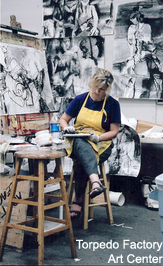 Traveling to and within Old Town Alexandria is easy. The King Street Metro Station is on the blue and yellow lines and the free King Street Trolley runs from the Metro station all the way down to the waterfront and back. There are also river cruise boats, buses, several large parking garages, and street parking.
Traveling to and within Old Town Alexandria is easy. The King Street Metro Station is on the blue and yellow lines and the free King Street Trolley runs from the Metro station all the way down to the waterfront and back. There are also river cruise boats, buses, several large parking garages, and street parking.
The Mount Vernon Trail, a popular walking and bike path, parallels the river. An old US Naval torpedo factory is situated at the waterfront. After the factory closed in 1945, the Smithsonian Institution and Congress stored items and documents there. It was renovated in the 1970s and reopened in 1983 as the Torpedo Factory Art Center, housing artists’ studios, shops, and an archeology museum with artifacts from the area dating back to 2,500 BC.
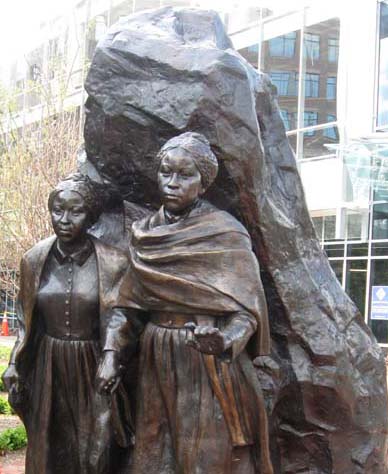 Market Square, the unofficial center of Old Town, is the oldest continuously operating marketplace in the United States and the site of the Alexandria City Hall. It was also once the site of the second-largest slave market in the US. Given all its history, it is not surprising that Alexandria was also important to the anti-slavery movement, with figures such as Edward Stabler, the Edmonson sisters, and Samuel W. Tucker.
Market Square, the unofficial center of Old Town, is the oldest continuously operating marketplace in the United States and the site of the Alexandria City Hall. It was also once the site of the second-largest slave market in the US. Given all its history, it is not surprising that Alexandria was also important to the anti-slavery movement, with figures such as Edward Stabler, the Edmonson sisters, and Samuel W. Tucker.
Here are your convention planners’ favorite parts of Old Town Alexandria:
- authorauthor- I love the Torpedo Factory. You can stroll from studio to studio, looking at the paintings, textile work, stained glass, pottery, jewelry, sculpture, and more, and you can buy directly from the artists. Step out the back and you’re on the boardwalk, where you can see street performers, boats, and a great view of the bridge.
- crrcookie – I have always enjoyed the free King Street Trolley. It gives me the freedom to walk when I choose and know that I will always be able to ride back to the King Street Metro Station if I (or lilgrovers) get tired.
- KateKintail- My favorite spot is a toss-up between two shops: the Scottish Merchant—an adorable little store with a wide selection of Scottish regalia, music, books, and other Celtic items—and the Christmas Attic—an amazing 3-story store packed full of ornaments, village scenes, and collectibles for all seasons.
- mdm139- I love the small park near the marina. It’s a great place for a picnic. I get to watch the boats and planes and my son, T-train, gets to run around.
- melydia- My favorite place is the Old Presbyterian Meeting House burial ground. It’s a Revolutionary War cemetery, with graves literally lining the walkways – and a playground at one end. I love the strange coexistence of youth and death.
Want to explore Old Town Alexandria while you’re here for the convention? You’re in luck, because you have three chances to visit it! We will have a trip to Old Town Alexandria on Friday afternoon for all early birds. This will include a ride on the free King Street Trolley, strolling along the waterfront, visiting the Torpedo Factory Art Center, and shopping near Market Square. On Sunday, one of the activities you can choose is to go on a special tour and release walk hosted by none other than our very own BookCrosser, ResQgeek. And for those BookCrossers sticking around after the convention, the hanger-on dinner Sunday evening will be in Old Town Alexandria as well, but the dinner is limited to the first 100 attendees who sign up so reserve your spot now!
Adventures at the Washington Monument
This post is part 3 of our Wednesday Adventure Series. Each week we will highlight something different in the Washington, D.C., Metro Area, many of which will be options for part of your own BookCrossing Journey. With so many things to see and do, how will you choose?
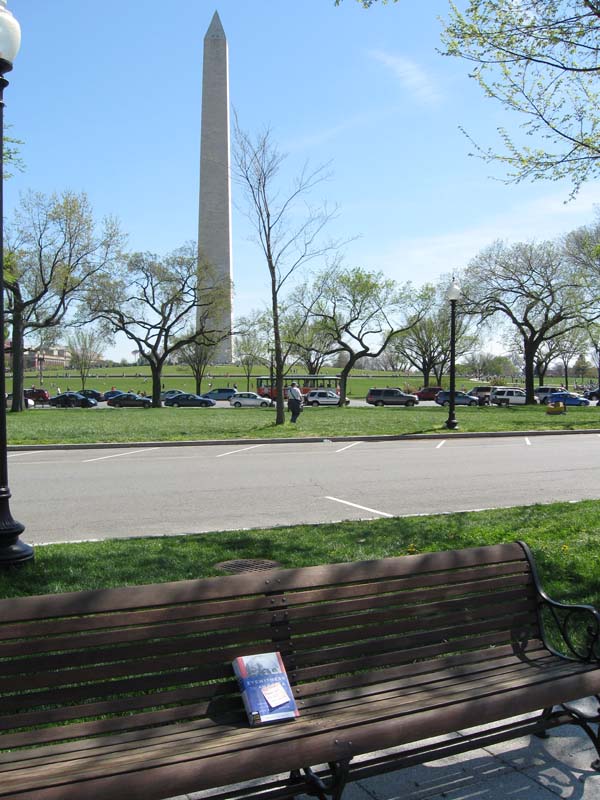 The Washington Monument is perhaps the most recognizable structure in all of Washington, D.C. It appears on many postcards and souvenirs, dominates the skyline, and is visited by over 670,000 people each year. At 555 feet 5.5 inches (169.294 meters) tall, it is the world’s tallest stone structure and the world’s tallest obelisk. You may have even seen it destroyed in films such as Mars Attacks or 2012.
The Washington Monument is perhaps the most recognizable structure in all of Washington, D.C. It appears on many postcards and souvenirs, dominates the skyline, and is visited by over 670,000 people each year. At 555 feet 5.5 inches (169.294 meters) tall, it is the world’s tallest stone structure and the world’s tallest obelisk. You may have even seen it destroyed in films such as Mars Attacks or 2012.
For all its modern fame, this monument to first US president George Washington almost wasn’t finished. Construction of the Monument began in 1848, but halted in 1854 due to political infighting and lack of funds. The nativist and anti-Catholic “Know-Nothing” Party took over the project in 1849, and though stones had been donated from numerous sources, one in particular caused quite a stir. The Know-Nothings objected to the block from Pope Pius IX and reportedly threw it into the Potomac. Congress rescinded further funding, and the missing “Pope Stone” was not replaced until 1983.
Though the Know-Nothings eventually gave up on the Monument, the Civil War and other funding issues kept construction on the Monument from continuing until 1876, after it had stood at less than one-third its proposed height for nearly two decades. You can still see a line about 150 feet up where the coloring of the stone changes.
The Monument was finally dedicated in 1885, when it was the tallest structure in the world. This title was short-lived, however, as it was bested by the Eiffel Tower by more than 500 feet in 1889. The 9-inch pyramid on the very tip of the capstone is made of solid aluminum, which was worth as much as silver in the 1880s. This tiny metal pyramid is nearly impossible to see from the ground, but one very visible addition near the top of the tower are flashing red lights to warn airplanes from flying too close.
Touring the Washington Monument is free, but tickets are required. Same-day tickets are issued on a first-come, first-served basis every morning starting at 8:30 AM. One person can reserve up to six tickets. If you reserve your ticket online ahead of time, there is a service fee of $1.50. Tours are available between 9:00 AM and 5:00 PM, with the last tour beginning before 4:45 PM. If you plan to visit, keep in mind that food, drink, large bags, and strollers are not allowed, and there is no public restroom on site.
For those who collect National Park Service passport stamps, the nearby Washington Monument Bookstore has about twenty.
Though a tour of the Washington Monument is not specifically part of the schedule for the 2011 BookCrossing Convention, there will be plenty of time if you would like to visit it on your own. Daunted by the crowds? Do what the locals do: visit the Clock Tower at the Old Post Office, located at the corner of 12th St NW and Pennsylvania Ave NW. Standing at 315 feet and offering a 360-degree view, the only taller structure in sight is the Washington Monument itself. Tours are free and almost never crowded. As an added bonus, the pavilion houses a wide variety of restaurants and gift shops.
Adventures at the Book Thing of Baltimore
This post is part 2 of our Wednesday Adventure Series. Each week we will highlight something different in the Washington, D.C., Metro Area, many of which will be options for part of your own BookCrossing Journey. With so many things to see and do, how will you choose?
 Have you ever dreamed of visiting a building full of absolutely free books just sitting there for the taking? That dream can become a reality when you visit the Book Thing of Baltimore, Inc. The mission of this nonprofit is to put unwanted books into the hands of those who want them. It’s basically a place where people donate books of various conditions (some are brand new, some are well-loved) and you’re welcome to help yourself to as many books as you like for free, though there is a daily limit of 150,000 per person. What’s the catch? There isn’t one! And the suggested donation is a smile. More information about the Book Thing can be found on their website.
Have you ever dreamed of visiting a building full of absolutely free books just sitting there for the taking? That dream can become a reality when you visit the Book Thing of Baltimore, Inc. The mission of this nonprofit is to put unwanted books into the hands of those who want them. It’s basically a place where people donate books of various conditions (some are brand new, some are well-loved) and you’re welcome to help yourself to as many books as you like for free, though there is a daily limit of 150,000 per person. What’s the catch? There isn’t one! And the suggested donation is a smile. More information about the Book Thing can be found on their website.
The place is divided by section (fiction, nonfiction, travel, history, biographies, children’s, romance, science fiction, mystery, science, animals, gay and lesbian literature, textbooks, philosophy, magazines, etc.) but apart from that, there’s no ordering system. One of our favorite sections is “Recommended by Russell,” a double-sided set of bookcases that contain owner Russell Wattenberg’s personal favorite, recommended books. The inventory of the Book Thing is based entirely on donations so it varies from day to day. Therefore, it’s tough to visit the Book Thing with a specific book in mind. However, it’s a great place to visit if you love being around books and browsing. Sometimes you stumble upon just the book you’re looking for; other times, you get great ideas for themed releases or gifts. Every book is stamped on the first page to let people know it’s a free book and cannot be resold.
The Book Thing opened its doors in 1999 as a way for people to get rid of books they no longer have use for and pass them on to new readers. Before it was a building, it was a box of books people could look through in the back of Russell’s car. Soon, people were giving him books for that “book thing…” he did, and the name stuck. Now he accepts donations from individuals, businesses, organizations, and libraries.
The Book Thing is open only on Saturdays and Sundays, but you’re in luck: we’re organizing a trip to it on the Sunday during our convention. Just sign up for this in the Add-Ons form to reserve your spot. The Book Thing can be impressive but it’s also small, so we might be limiting attendance and staggering our groups. We might even stop by several sites related to Edgar Allan Poe while we’re in Baltimore. Hundreds of free books are waiting for you; sign up today!





